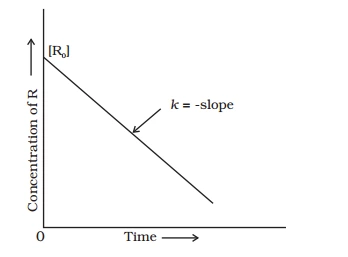Examples And Numericals Of Zero Order Reaction
Examples And Numericals Of Zero Order Reaction
Definition of Zero Order Reaction
It can be defined as a chemical reaction that linearly and gradually decreases its reactant concentration with time. The zero-order reaction is related to the speed of a chemical reaction in terms of reactants and products. Here, the rate of reaction does not change with the increase or decrease in the reactants’ concentration. Along these lines, the rate of these reactions is continuously equivalent to the rate constant of the particular reactions. It is due to the rate of these reactions is directly proportional to the zeroth power of concentration of reactants.
Deriving Zero-order reaction
The rate of reaction in terms of product,

k₀ is the zero-order reaction rate constant.
Now, we can write, dx = k0 . dt
On doing the integration of the above equations within limits, 0 to x and 0 to t, we get,

Hence, x = k0t + c, where c is the integration constant.
Considering the Case when ‘t’ is zero, and ‘x’ is also zero, therefore, the integration constant ‘c’ is zero as well.
We deduce, x = k0t
This is the relationship between the decrement of the concentration of the reactant with respect to time.
This form allows us to determine the concentration of the reactant at any given time after the reaction begun.
Graph of Zero Order Reaction
The integral form of zero-order reactions can be rewritten as
[A]=–kt+[A0]
On comparing it, with straight line equation (y = mx + c),
A graph can be plotted between [A] and ‘t’ to get a straight line with slope equal to ‘-k’ and intercept equal to [A]0 as depicted below.

Zero-order reaction half-life equation
Since we know already that half-life means 50% of reactants disappear in the given time interval.
The rate equation for zero-order reactions can be written as,
C0 – CA = k0t
Where, CA is the concentration of the reactant at the time t.
C0 is the initial concentration of the reactant
But when t = t½, that is the half-life of the reaction completed, the concentration of the reactant
CA = CA/2


Thus the half-life of the zero-order reactions is absed on the initial concentration of the reactant.
Characteristics of Zero-Order Kinetics
- Half-life of zero-order reaction is proportional to the initial concentration of the reactant.
- The rate of the reaction is independent of concentration.
- The rate of the reaction is always equal to the rate constant of the reaction at all concentrations.
- The concentration of reactant declines linearly with time.[A]t = [A]0 – kt
- The time needed for the reaction to finish, i.e., time at which [A] is zero.
tcompletion = [A]0/k = (Initial concentration)/(Rate constant)
- The units of k are mol L-1 time-1.
Examples of Zero Order Reaction
In spite of the fact that the reactions which have a general order of zero are uncommon. The compound catalyzed reaction is the case of zero-order reaction as for the substrate.
The reactions mentioned below are instances of zero order reactions that are independent of the concentration of the reactants.
Photochemical reaction between hydrogen and chlorine:
H2(g) Cl2(g)  2HCl(g)
2HCl(g)
This photochemical reaction is zero-order reaction. The reaction is concentrated by setting H2 and Cl2 gases over water. The rate of reaction is determined by the rate at which water increases in the vessel because of dissociation of HCl shaped. The rate of ascent of water is equivalent to the rate of vanishing of H2 and Cl2. It means that the concentration of the gaseous phase won't change with time, despite the fact that the amounts will change.
Decomposition of NH3 in presence of molybdenum or tungsten
2NH3  N2 + 3H2
N2 + 3H2
The surface of the catalyst is totally covered by NH3 molecules. The adsorption of gas on the surface can't change by elevating the pressure or concentration of ammonia molecules. Along these lines, the concentration of gaseous phase stays steady in spite of the fact that the product is created. Hence, it is a zero order kinetics reaction
Rate of formation of NO2
The chemical reaction for the formation of NO2

The rate equation for this reaction

If the rate of disappearance of N2O5 = x, then the rate of formation of NO2 = 2x.
Reactions wherein a catalyst is needed are commonly zero order reactions. The unit of the rate consistent in a zero order reaction is given by concentration/time or M/s; 'M' is the molarity and 's' alludes to per second.
Now, we can write, dx = k0 . dt

tcompletion = [A]0/k = (Initial concentration)/(Rate constant)
Similar Questions
Examples And Numericals Of First Order Reaction
View SolutionExamples And Numericals Of A Second Order Reaction
View SolutionIn a zero order reaction:
View SolutionFor a zero order reaction
View SolutionFor a zero order reaction
View SolutionFor a zero order reaction :
View SolutionGraphs based on Zero Order Reaction and its numericals | First Order Reaction
View SolutionExplain the kinetics of zero order reaction.
View SolutionRate Law | Zero Order Reaction | Characteristics of Zero Order Reaction
View SolutionIntegrate Rate Equation for Zero Order Reaction || Characterstics OF Zero Order Reaction
View Solution


